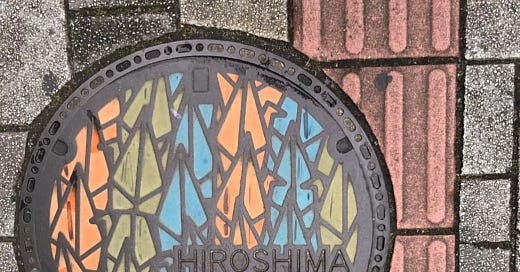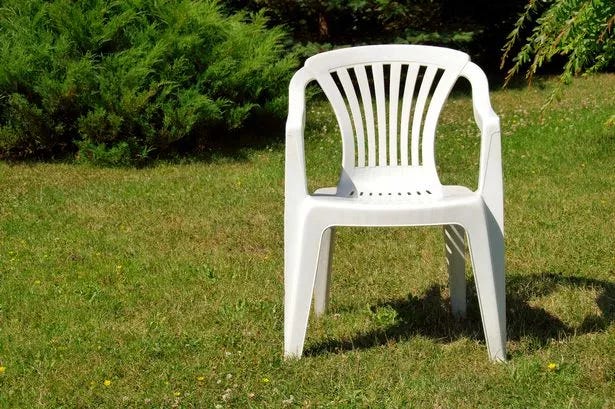This week’s Design Lobster features some designs that would be easy to overlook. We’re covering the story of the world’s most ubiquitous plastic chair and some surprisingly beautiful manhole covers from Japan. Read on, and look a little closer… 👀
Question: Why are Japanese manhole covers so beautiful?

Walking around the streets of Japanese towns and cities, tourists are often surprised and delighted to discover the lavish care that has been taken over ordinary urban infrastructure, a reflection of the aesthetic philosophy of kawaii (可愛い) that we covered in Design Lobster #44.
Perhaps the most surprising example of this is the manhole cover, which in Japan comes decorated in hundreds of regional variations that use pattern and carefully chosen characters and scenes to tell local stories. The origami design in the example above from Hiroshima is a reference to the famous children’s story of Sadako and the Thousand Paper Cranes and there are many more such examples that incorporate flowers, landscapes and even animé characters.
Curiously enough, the idea to decorate manholes in this way began in the 1980s as a PR strategy. At that time, just 60% of homes in Japan had sewage system connections, and upgrading them was expensive and unpopular. To garner public backing for this endeavour, local authorities were invited to customise their manhole designs and make them a source of local pride. This approach was hugely successful, even sparking the phenomenon of “drainspotting” where tourists travel to obscure corners of the country to see especially rare designs.
Indeed in 2016, Japanese authorities formalised this activity by releasing collectible cards for certain manholes so that would-be drainspotters could keep a record of their efforts, and earn discounts in shops and cafés in the places they visited. As we grapple with how to build all the extra infrastructure required for the Net Zero transition, I can’t help but feel that there are lessons to learn from these much-loved manholes.
Design takeaway: What would make your design so popular that people would travel to see it?
🕳️ Check out “drainspotting” Youtube 🤯
Enjoying Design Lobster? Share it with a friend, colleague or fellow designer 🤲🦞
Object: Monobloc chair
Injection-moulded from between two and three kilograms of propylene plastic into a single structural element, the Monobloc chair is extremely easy to mass-produce, with some estimating that more than a billion have been created since the 70s when the technique was originally invented. Monobloc chairs are unusual in that they are simultaneously instantly recognisable and completely nondescript, and in the West they have become a symbol of cheap consumerism, plastic pollution and bad taste. But when your first instinct is to sneer, its easy to miss what a remarkable phenomenon their design represents.
Like many examples of ubiquitous design there is no individual inventor to credit, though Verner Panton’s 1967 Panton chair and Henry Massonet’s 1972 Fauteuil 300 are clear precursors, experimenting with the then-new technology of injection-moulded plastic. But it was not until the 80s when costs were brought down that Monobloc chairs began to be sold in their millions.
It’s conventional wisdom these days to view these chairs as an ecological catastrophe, created as they are from fossil fuel by-products. But in his 2021 documentary Monobloc, Hauke Wendler makes the case for widening our perspective and re-assessing these chairs in light of the transformative access to furniture they have provided to low-income families in the developing world.
Design takeaway: What would it take for your design to become ubiquitous?
🪑 Watch a trailer of Hauke Wendler’s film about Monobloc chairs
Quote: “Extraordinary things are always hiding in the places people never think to look.”
– Jodi Picoult
Staying curious and learning to notice things that others miss are recurring themes in this newsletter. I thought this quote from writer Jodi Picoult was a particularly nice expression of these sentiments.
Hope you find something extraordinary this week,
Ben 🦞
And lastly, a design remix…

Enjoyed this week’s Design Lobster? Let me know by clicking the heart button ❤️
👇





Really enjoy your seemingly random topics thank you.